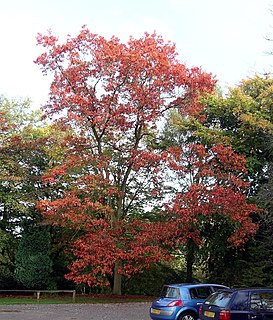
Quercus rubra, the northern red oak, is an oak tree in the red oak group. It is a native of North America, in the eastern and central United States and southeast and south-central Canada. It grows from the north end of the Great Lakes, east to Nova Scotia, south as far as Georgia, Mississippi, Alabama, and Louisiana, and west to Oklahoma, Kansas, Nebraska, and Minnesota. It has been introduced to small areas in Western Europe, where it can frequently be seen cultivated in gardens and parks. It prefers good soil that is slightly acidic. Often simply called red oak, northern red oak is so named to distinguish it from southern red oak, also known as the Spanish oak. Northern Red Oak is sometimes called champion oak. It is also the state tree of New Jersey and the provincial tree of Prince Edward Island.
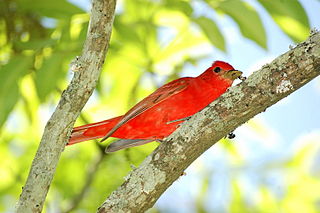
The summer tanager is a medium-sized American songbird. Formerly placed in the tanager family (Thraupidae), it and other members of its genus are now classified in the cardinal family (Cardinalidae). The species's plumage and vocalizations are similar to other members of the cardinal family.

Alnus rubra, the red alder, is a deciduous broadleaf tree native to western North America.

The red mouse opossum is a South American marsupial of the family Didelphidae. Its range includes eastern Ecuador and Peru.
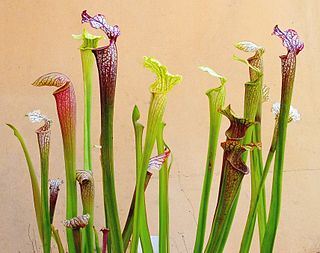
Sarracenia is a genus comprising 8 to 11 species of North American pitcher plants, commonly called trumpet pitchers. The genus belongs to the family Sarraceniaceae, which also contain the closely allied genera Darlingtonia and Heliamphora.

Ulmus rubra, the slippery elm, is a species of elm native to eastern North America, ranging from southeast North Dakota, east to Maine and southern Quebec, south to northernmost Florida, and west to eastern Texas, where it thrives in moist uplands, although it will also grow in dry, intermediate soils. Other common names include red elm, gray elm, soft elm, moose elm, and Indian elm. The tree was first named as part of Ulmus americana in 1753, but identified as a separate species, Ulmus rubra, in 1793 by Pennsylvania botanist Gotthilf Muhlenberg. The slightly later name U. fulva, published by French botanist André Michaux in 1803, is still widely used in dietary-supplement and alternative-medicine information.

Myrica rubra, also called yangmei, yamamomo, Chinese bayberry, Japanese bayberry, red bayberry, yumberry, waxberry, or Chinese strawberry is a subtropical tree grown for its fruit.

Cephalanthera rubra, known as red helleborine, is an orchid found in Europe, North Africa and southwest Asia. Although reasonably common in parts of its range, this Cephalanthera has always been one of the rarest orchids in Britain.

Acanthophoenix rubra, the barbel palm, is a critically endangered palm endemic to Mauritius, Rodrigues, and La Reunion that is prized for its edible palm hearts.
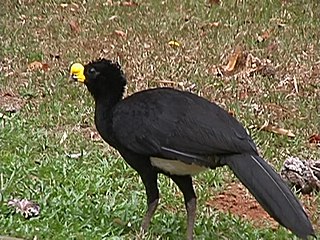
The great curassow is a large, pheasant-like bird from the Neotropical rainforests, its range extending from eastern Mexico, through Central America to western Colombia and northwestern Ecuador. Male birds are black with curly crests and yellow beaks; females come in three colour morphs, barred, rufous and black. These birds form small groups, foraging mainly on the ground for fruits and arthropods, and the occasional small vertebrate, but they roost and nest in trees. This species is monogamous, the male usually building the rather small nest of leaves in which two eggs are laid. This species is threatened by loss of habitat and hunting, and the International Union for Conservation of Nature has rated its conservation status as "vulnerable".

Filipendula rubra, also known as queen-of-the-prairie, is a species of flowering plant in the family Rosaceae native to the northeastern and central United States and southeastern Canada. It prefers full sun or partial shade and moist soil, but tolerates drier soil in a shadier location. It grows tall and firm, and produces blooms that are tiny and pink above its ferny, pointy leaves.

The Aldabra flying fox is a species of megabat in the genus Pteropus. It is endemic to the Aldabra Atoll in the Seychelles, like Chaerephon pusilla, though the latter may be the same species as the little free-tailed bat.

The mottled grouper is a species of marine ray-finned fish, a grouper from the subfamily Epinephelinae which is part of the family Serranidae, which also includes the anthias and sea basses. It is found in the eastern Atlantic Ocean and the Mediterranean Sea.

Plumeria rubra is a deciduous plant species belonging to the genus Plumeria. Originally native to Mexico, Central America, Colombia and Venezuela, it has been widely cultivated in subtropical and tropical climates worldwide and is a popular garden and park plant, as well as being used in temples and cemeteries. It grows as a spreading tree to 7–8 m (23–26 ft) high and wide, and is flushed with fragrant flowers of shades of pink, white and yellow over the summer and autumn.

Anomia is a genus of saltwater clams, marine bivalve mollusks in the family Anomiidae. They are commonly known as jingle shells because when a handful of them are shaken they make a jingling sound, though some are also known as saddle oysters.

"Nepenthaceae" is a monograph by John Muirhead Macfarlane on the tropical pitcher plants of the genus Nepenthes. It was published in 1908 in Adolf Engler's Das Pflanzenreich. It was the most exhaustive revision of the genus up to that point, covering all known species, and included detailed accounts of the structure, anatomy, and development of Nepenthes.

Atlantilux rubra is a species of sea snail, a marine gastropod mollusk, in the family Costellariidae, the ribbed miters.
Villagorgia is a genus of gorgonian-type octocorals in the family Plexauridae.
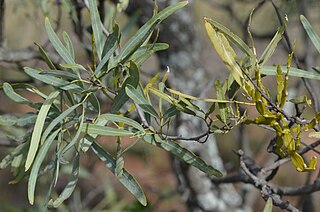
Korthalsella rubra is a flowering plant in the Santalaceae (sandalwood) family, formerly placed in the Viscaceae.

Lasaea rubra is a species of small marine bivalve mollusc in the family Lasaeidae. It is found on the eastern side of the Atlantic Ocean. This species was first described in 1803 by the English naturalist George Montagu who gave it the name Cardium rubrum. It was later transferred to the genus Lasaea, making it Lasaea rubra.



















